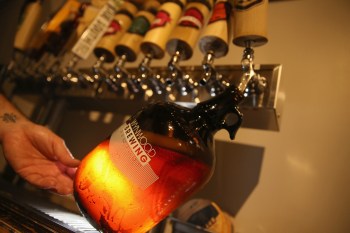The beer packaging debate: Bottle vs. can
Kai Ryssdal: Yesterday was — for the uninitiated among you — International IPA Day. India Pale Ale, it’s beer. What I’m about to say is a matter of some debate, but good beer — really good beer — often comes from microbreweries. They typically cost more, but conventional wisdom holds microbrews are better than mass-produced fizzy yellow stuff in part because they usually come in bottles.
Conventional wisdom, however, isn’t always right. LaToya Dennis reports from WUWM in Milwaukee.
LaToya Dennis: It’s a Thursday night, and for college kids, the unofficial start of the weekend. Students from the University of Wisconsin, Milwaukee, file into Gilbert’s liquor store.
Architecture major Casey Carney heads straight for his beverage of choice.
Casey Carney: Flying Dog.
That would be Flying Dog, a microbrew out of Maryland. Right now, it only comes in glass bottles, and Carney says that’s exactly the way he wants it.
Carney: Aluminum cans, that aluminum gets into the beer and it does make it taste different.
Russ Phillips runs the blog CraftCans.com. It tracks and reviews microbrews.
Russ Phillips: There is definitely a stigma attached to cans.
But a growing number of craft brewers is trying to change that perception. By Phillips’ count, nearly 400 microbrews have turned to cans.
Phillips: When I first started the website 14 months ago, it seemed like about every month I’d hear of a brewery that was gonna can one of their beers. Now it’s almost a daily occurrence from someone.
Jeff Hamilton is president of Sprecher Brewing Company in Milwaukee. A few months ago, the company started putting some of its Special Amber Beer in cans. He says the main reason for the switch was cost.
Jeff Hamilton: When it leaves here, it’s considerably cheaper than the glass bottles. I know that our distributors have passed that on, as have the retailers.
At a nearby grocery store, a bottle of Special Amber was going for $1.75. But a can was more than 50 cents cheaper. And Hamilton says the advantages don’t end there.
Hamilton: Cans are much better for the beer. Beer doesn’t like light and beer doesn’t like oxygen — and the can completely keeps the beer in the dark and it’s hermetically sealed so that no oxygen can get in.
Still, traditionalists like architecture student Casey Carney remain skeptical about beer in cans. But is there really a difference in taste? To find out I asked Carney to take a blind taste test with Sprecher Special Amber.
Dennis: All right. Why don’t you try the glass on the left first?
Carney: OK, we’ll see.
Dennis: All right, now you can try the other.
Carney: I have to say that’s the aluminum.
Dennis: You think so?
Carney: I think so. Yes.
Dennis: Casey, you’re wrong man.
Carney: I’m wrong? Oh no! Well I definitely can tell that there’s a difference. But I guess, I guess I was wrong.
Now, Carney says, the next time he’s in Gilbert’s liquor store, he’s going to give canned beer a second look.
In Milwaukee, I’m LaToya Dennis for Marketplace.
There’s a lot happening in the world. Through it all, Marketplace is here for you.
You rely on Marketplace to break down the world’s events and tell you how it affects you in a fact-based, approachable way. We rely on your financial support to keep making that possible.
Your donation today powers the independent journalism that you rely on. For just $5/month, you can help sustain Marketplace so we can keep reporting on the things that matter to you.


















